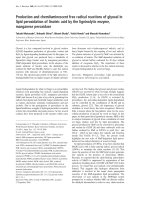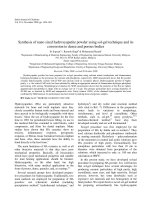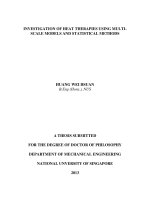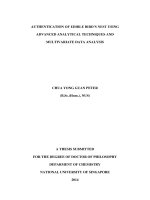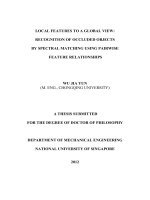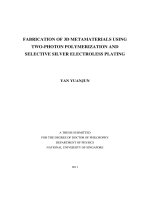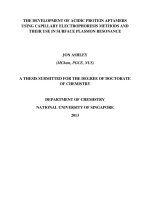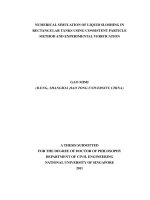Pretreatment of rice straw using deep eutectic solvent and saccharification of pretreated residue by crude cellulase enzyme
Bạn đang xem bản rút gọn của tài liệu. Xem và tải ngay bản đầy đủ của tài liệu tại đây (130.8 KB, 7 trang )
Int.J.Curr.Microbiol.App.Sci (2019) 8(10): 1812-1818
International Journal of Current Microbiology and Applied Sciences
ISSN: 2319-7706 Volume 8 Number 10 (2019)
Journal homepage:
Original Research Article
/>
Pretreatment of Rice Straw using Deep Eutectic Solvent and
Saccharification of Pretreated Residue by Crude Cellulase Enzyme
Poonam Maan* and R. S. Sengar
Department of Agriculture Biotechnology, College of Agriculture, Sardar Vallabhbhai Patel
University of Agriculture and Technology, Meerut-250110, India
*Corresponding author
ABSTRACT
Keywords
Woody biomass,
Agricultural
residues, Rice
straw, Lignin
extraction, Fossil
fuel
Article Info
Accepted:
15 September 2019
Available Online:
10 October 2019
The present study demonstrated the pretreatment of rice straw using deep
eutectic solvent (DES), choline chloride:urea and its comparison with acid
and alkaline pretreatment. At a solid loading of 10%, choline chloride
(ChCl):urea (1:2) was very effective in lignin extraction from rice straw at
45 °C. It is showed that nearly 40% of lignin was separated in a single step.
However, enzymatic hydrolysis of pretreated rice straw with crude cellulase
enzyme produced from C.cinereaRM-1 showed the reducing sugar yield of
385±8 mg/g with a saccharification efficiency of 31.5±2.5 % in 48 h at 10
% solids loading.
Introduction
With the increasing world’s population,
energy consumption has increased many folds
over the last century. Fossil fuel has been the
major source of energy that formed from
fossils over millions of years within the earth.
Fossil fuels are considered as nonrenewable
and depleting continuously with a predicted
estimation from the 25 billion barrels to
approximately 5 billion barrels till 2050
(Campbell and Laherrere, 1998). On the other
hand, a large amount of agro-industrial
wastes and crop residues are generated all
over the globe and creates many
environmental problems if not utilized
properly. Mainly three categories of
lignocellulosic biomass; woody biomass,
agricultural residues, and energy crops are
produced. Among the agricultural residues,
rice straw is generated in abundance (667.6
million tons) in Asian countries every year
and would serve as a great potential feedstock
for biofuel production. After harvesting the
rice, large amount of rice straw residues i.e.,
40-50 cm of loose stubble and 50-60 cm of
standing straw are usually left over the field
and it is still burnt in the fields causing severe
environmental and health issues (Liu et al.,
2011; Binodet al., 2010). It is estimated that
1812
Int.J.Curr.Microbiol.App.Sci (2019) 8(10): 1812-1818
approximately 205 billion liters of bioethanol
can potentially be produced annually by using
rice straw (Belal, 2013). Rice straw consists of
mainly cellulose (32–47 %), hemicellulose
(19–27 %), and lignin (5–24 %).
Therefore, considering the above problems,
efforts have been concentrated in exploring
the alternative energy sources such as biofuels
(biodiesel and bioethanol) by utilizing
lignocellulosic biomass. The most important
biomass processing challenge is the
pretreatment for production of biofuels and it
should be simple, environmental friendly and
economically feasible (Ravindran et al.,
2018). Pretreatment is required for loosen the
complex structure of lignocellulosic biomass.
Moreover, lignocellulosic biomass requires
suitable
pretreatment
method
for
solubilization, separation and conversion of its
cellulose and hemicellulose components into
fermentable sugars (Sun et al., 2016). In
addition, a successful pretreatment process
increased the yields of hydrolysis, reduces the
product degradation and reduces the formation
of inhibitory byproducts. A list of
pretreatment methods have been developed for
different lignocellulosic biomass over the past
few decades but till now, there is no single
pretreatment method available that could suit
to all types of biomass. The most commonly
used fundamental types of pretreatment
technologies for lignocellulosic biomass
include usage of common organic solvents.
These technologies have many disadvantages
such as low yield, high processing cost and
create health and environmental issues (Anwar
et al., 2014; Alvira et al., 2010). Therefore, a
continuous search is constantly on-going
towards more novel, cheaper and efficient
green technologies over the past Decade, for
solving these challenges (Liu et al., 2014; Dai
et al., 2013a; Capolupo and Faraco, 2016).
Recently, the “Green Chemistry” concept has
emerged as a possible solution to the
challenge
of
using
nontoxic
and
environmental friendly materials for efficient
utilization of lignocellulosic biomass. Ionic
liquids (ILs) and Deep Eutatic Solvents (DES)
are currently gaining importance as an
alternative to conventional pretreatment
technologies of biomass. ILs possesses
attractive properties due to their higher
thermal and chemical stability, negligible
vapor pressure and non-flammability nature
(Wahlström and Suurnäkki, 2015; Wu et al.,
2014). However, the use of ILs in the
pretreatment is environmentally friendly but it
is a cost-intensive process; this limits its use in
biorefinery (Hou et al., 2013). Recently,
similar to the ILs, DES attracts the attention as
a potential green and designer solvent with
several chemical and biological applications
(Dai et al., 2013a, b; Choi et al., 2011; Huang
et al., 2013). According to Paiva et al., (2014),
the yield of the DES preparation process may
be considered 100 % as no chemical reaction
takes place in its production and total waste
production is zero.DES is a mixture of a
hydrogen-bond acceptor and donor; in most
cases, a quaternary ammonium halide salt act
as a hydrogen-bond acceptor and amino acid,
urea, amine, carboxylic acid or carbohydrate
etc. act as a hydrogen-bond donor (Francisco
et al., 2012; Zhang et al., 2012). DES has been
used extensively in the recent past years in the
pretreatment of lignocellulosic biomass for
achieving high hydrolysis and fermentation
yields. In the current investigation, the
pretreatment of rice straw through acid, alkali
and DES (ChCl/Urea) and enzymatic
hydrolysis for fermentable sugar production
were reported.
Materials and Methods
Microorganism and enzyme production
The microorganism used in this study for
cellulase enzyme production, was isolated
from decomposing wood samples and
identified as C. cinereaRM-1 NFCCI-3086 by
1813
Int.J.Curr.Microbiol.App.Sci (2019) 8(10): 1812-1818
National Fungal Culture Collection of India,
Agharkar Research Institute, Pune, India.
Growth conditions of C. cinerea RM-1 for
cellulase enzyme production were set as
described by Poonam (2015).
Raw material and chemicals
Rice straw was procured from the local rice
field and washed 3-4 times in distilled water,
dried and powdered using laboratory grinder,
dried again and stored in polythene begs. This
rice straw was used as lignocellulosic biomass
for pretreatment studies. Carboxymethyl
cellulose (CMC), birchwoodxylan, glucose,
xylose, and arabinose were purchased from
Sigma. All other chemicals and reagents were
of analytical grade.
DES
preparation
pretreatment
and
rice
straw
DES reagent was prepared in capped bottle by
mixing ChCl/Urea at a molar ratio of 2:1 and
incubated in incubation shaker at 100 rpm and
70 °C until a clear liquid solution was
obtained (Dai et al., 2013a, Francisco et al.,
2013b). Various pretreatment experiments
including, 2% H2SO4, 2% NaOH and DES
solvent (ChCl/Urea) were carried out in screw
capped conical flasks at 10% solid loadings
unless mentioned. Briefly, 10g of rice straw
was mixed with 2% H2SO4, 2% NaOH and
DES solvent in a solid/liquid ratio of 1:10
separately, and subjected to steam treatment at
121 °C and 15 psi pressure for 30 min.
Following this, the samples were washed with
distilled water for three times. Control and
pretreated rice straw samples were analyzed
for cellulose, hemicellulose and lignin content.
for 3h. After incubation, the mixture was
centrifuged at 10000×g for 15 min, and the
pellet was washed with distilled water three
times and air-dried to obtain lignin powder.
DES was recovered from water solution by
incubation in vacuum rotary evaporator at 60
°C. The recovered DES and pure water may
be reused in the next biomass pretreatment
and lignin precipitation cycle.
Solubility evaluation test of cellulose, xylan,
and lignin in DES
Pure cellulose, xylan, and lignin were used for
Specific solubility test in DES reagents. All
three components were dissolved in 10 ml
ChCl/Urea at a molar ratio of 2:1 and 3:1
separately in 10% concentration and incubated
at 60 °C for 12h. All samples were filtered
through fiber glass filters and dried at 60 °C.
The solubility (%) of the NADES reagent was
determined by calculating the weight of dried
components.
Enzymatic hydrolysis of pretreated rice
straw
Enzymatic scarification experiments were
carried out at 10% solid loading and cellulase
enzyme dose of 10 IU per g in a total reaction
volume of 10-ml with citrate buffer in 50-ml
sealed bottles. The prepared mixtures were
then incubated at 45 °C and15 rpm for 24 and
48h.
The reducing sugars were measured by DNS
method
(Miller,
1959).The
Control
experiments were carried out separately either
by avoiding cellulose enzyme or the pretreated
substrate.
Lignin separation and recovery of DES
Analytical methods
DES was separated from lignin by adding
distilled water until the turbid solution
obtained. The solution was incubated at 5 °C
The cellulase activity (CMCase) was
determined using CMC as the substrate
following the protocol published by Mandels
1814
Int.J.Curr.Microbiol.App.Sci (2019) 8(10): 1812-1818
M. (1975). The compositional analysis of raw
and pretreated straw was done for determining
the cellulose, hemicellulose, and lignin
content (Sluiter et al., 2008).
Results and Discussion
Pretreatment of rice straw
Table 1 represents the effects of different
solvents i.e., dilute acid, mild alkali and DES
on delignification of rice straw. Acid
treatment of rice straw has very high
detrimental effect on hemicellulose content
and it decreased from 24.6% to 1.2% while the
cellulose and lignin content are not affected to
much extent. After alkali pretreatment, the
overall cellulose content increased from
35.5% to 43.8% in pretreated rice straw while
hemicellulose and lignin content decreased
from 24.6% to 18.5% and from 14.5% to
11.56%, respectively. DES pretreatment of
rice straw resulted in decrease in lignin
content from 14.5% to 8.7%, while cellulose
content was increased from 35.5% to 45.8%
and hemicellulose content decreased from
24.6% to 21.5%. Thus, it is observed that
lignin content was decreased about 40%
without affecting the hemicellulose very much
after DES pretreatment; thus the overall
amount of cellulose was enhanced. Generally,
acid pretreated biomass showed significant
loss in hemicellulose content (Hendriks and
Zeeman,2009). While, DES pretreatment
showed no severe effect on hemicellulose and
cellulose content of biomass. This trend may
found because choline chloride stabilizes the
cellulose by making hydrogen bond with it;
thus,
dissolution
of
cellulose
and
hemicellulose is inhibited (Abbott et al.,
2006). The cellulose content enhancement
after pretreatment may be due to the alteration
in biomass structure and crystalline cellulose
which might have increased the overall
cellulose availability (Kumar and Parikh,
2015). Kandanelli et al., (2018) reported the
removal of about 50% lignin from
lignocellulosic biomass by using n-butanol
assisted DES (ChCl: OA) at solid loading of
15 % (w/v)at 120°C for 60 min. Kumar et al.,
(2016) reported that approximately 58% lignin
was removed from rice straw after
pretreatment with NADES.
Table 2 represents the solubilization studies of
pure cellulose, hemicellulose and lignin in
DES solution. The pure cellulose and
hemicellulose showed no solubilization in
DES and remained untouched while lignin
showed high solubility (78%); this proves the
specificity
of
DES
towards
lignin
solubilization. While, the % solubility of
lignin when present in biomass was found to
be comparatively lower than the pure lignin in
DES. This could be due to the cross-linking
architecture of biomass and strong binding of
lignin to cellulose and hemicellulose which
poses the lignin to extract. These finding were
in close agreement with Kroon et al., (2014),
who reported that NADES showed very high
selectivity for separation of lignin from a
mixture of lignin and cellulose and that lignin
solubility values varied with different
combinations of NADES reagents.
Saccharification studies
Table 3 represents the enzymatic hydrolysis
results of rice straw pretreated with DES at
10% solids loading and 10 IU/g of crude
cellulase enzyme produced by C. cinerea. The
hydrolysis experiments were performed at 45
°C and15 rpm.
The reducing sugars were measured after 24
and 48 h. The results showed the maximum
saccharification efficiency of 31.5±2.5 % with
reducing sugar yields of 385±8 mg/g after 48
h. Our results were in line with Kumar et al.,
(2015) who reported that enzymatic hydrolysis
of rice straw showed reducing sugars yield of
333±11 mg g−1 and saccharification
efficiency of 36.0±3.2 % in 24 h at 10 %
solids loading.
1815
Int.J.Curr.Microbiol.App.Sci (2019) 8(10): 1812-1818
Table.1 Compositional analysis of raw and pretreated rice straw
S. No.
Treatment
Cellulose% Hemicellulose% Lignin%
Untreated rice straw
35.5±1.2
24.6±1.2
14.5±1.1
1.
Acid treated rice straw
34.2±2.2
1.2±0.8
13.6±0.9
2.
Alkali treated rice
43.8±3.4
18.52±1.1
11.56±0.9
3.
straw
DES treated rice straw
45.8±2.7
21.5±1.7
8.7±0.4
4.
Table.2 Solubility analysis of pure cellulose, xylan, and lignin in (ChCl/Urea)
DES reagent
ChCl/Urea
(2:1)
ChCl/Urea
(3:1)
% Solubility (10% (w/v)
substrate)
Cellulose Xylan
Lignin
0.0
0.0
75.1±6
0.0
0.0
73.5±5.5
Table.3 Enzymatic saccharification of DES pretreated rice straw biomass
Time of Saccharification
Reducing sugars (mg/g)
24h
48h
282±10
385±8
Here, we have revealed a green pretreatment
process for biomass using deep eutectic
solvent (ChCl/Urea) as a potential extraction
media for delignification from rice straw and
compared with acid and alkali treatment.
A high-quality lignin was extracted from
biomass and was separated from cellulose and
hemicellulose in a single step by simple
precipitation method.
The Results showed that approximately 40%
lignin were removed from rice straw using
DES treatment. Following delignification, the
residual rice straw was subjected to enzymatic
hydrolysis and a plenty amount of fermentable
sugars (385±8 mg/g) were produced with a
saccharification efficiency of 36.0±3.2
%.After pretreatment with DES, degradation
Saccharification efficiency
(%)
20±1.2
31.5±2.5
products such as furfural and hydroxyl methyl
furfural
are
not
formed;
therefore
detoxification step is not required which is a
key step after acid pretreatment.
Therefore, DES pretreatment decreases the
overall cost of process by reducing the postprocess steps and these green solvents may
absolutely be used as the next-generation
reagents for sustainable development.
Acknowledgement
The authors are thankful to Sardar
Vallabhbhai Patel University of Agriculture
&Technology, Meerut for providing the lab
facilities. The authors acknowledge the
financial support from University Grants
Commission, New Delhi, India.
1816
Int.J.Curr.Microbiol.App.Sci (2019) 8(10): 1812-1818
References
Abbott, A.P., Bell, T.J., Handa, S., and Stoddart,
B. 2006. Cationic functionalization of
cellulose using a choline based ionic liquid
analogue. Green Chem 8:784–786.
Alvira, P., Tomas-Pejo, M., Ballesteros, M., and
Negro,
M.J.
2010.
Pretreatment
technologies for an efficient bioethanol
production process based on enzymatic
hydrolysis: a review. Bioresour Technol
101:4851–4861
Anwar, Z., Gulfraz, M., and Irshad, M. 2014.
Agro-industrial lignocellulosic biomass a
key to unlock the future bioenergy: a brief
review. J Radiat Res ApplSci 7(2):163–173
Belal, B.E. 2013. Bioethanol production from
rice straw residues. Braz J Microbiol
44:225–234
Binod, P., Sindhu, R., Singhania, R.R., Vikram,
S., Devi, L., Nagalakshmi, S., Kurien, N.,
Sukumaran, R.K. and Pandey, A. 2010.
Bioethanol production from rice straw: an
overview. BioresourTechnol 101:4767–
4774.
Campbell, C.J., and Laherrère, J.H. 1998. The
end
of
cheap
oil. Scientific
American, 278(3), 78-83.
Capolupo, L., and Faraco, V. 2016. Green
methods of lignocellulose pretreatment for
biorefinery development. Appl. Microbiol.
Biotechnol. 100:9451–9467.
Choi, Y.H., Spronsen, J.V., Dai, Y., Verberne,
M., Hollmann, F., Arends, IWCE,
Witkamp, G.J. and Verpoorte, R. 2011.
Are natural deep eutectic solvents the
missing link in understanding cellular
metabolism and physiology. Plant Physiol.
156:1710–1705.
Dai, Y., Spronsen, J.V., Witkamp, G.J.,
Verpoorte, R., and Choi, Y.H. 2013a.
Natural deep eutectic solvents as new
potential media for green technology. Anal
ChimActa. 766:61–68.
Dai, Y.,Witkamp, G.J., Verpoorte, R., and Choi,
Y.H. 2013b. Natural deep eutectic solvents
as a new extraction media for phenolic
metabolites in Carthamus tinctorius L.
Anal Chem. 85:6272–6278.
Francisco, M., van den Bruinhorst, A., and
Kroon, M.C. 2012. New natural and
renewable low transition temperature
mixtures (LTTMs): screening as solvents
for
lignocellulosic
biomass
processing. Green Chemistry. 14(8): 21532157.
Francisco, M., van den Bruinhorst, A., Zubeir,
L.F., Peter, C.J., and Kroon, M.C. 2013b.
A new low transition temperature mixture
(LTTM) formed by choline chloride+lactic
acid: characterization as solvent for CO2
capture. Fluid Phase Equilib. 340:77–84
Hendriks A.T.W.M., and Zeeman, G. 2009.
Pretreatments to enhance the digestibility
of lignocellulosic biomass. Bioresour
Technol. 100:10–18
Hou, X.D., Li, N., and Zong, M.H. 2013. Facile
and Simple Pretreatment of Sugar Cane
Bagasse without Size Reduction Using
Renewable Ionic Liquids–Water Mixtures.
ACS
Sustainable
Chemistry
&
Engineering. 1(5):519-526.
Huang, Z.L., Wu, B.P., Wen, Q., Yang, T.X.,
and Yang, Z. 2013. Deep eutectic solvents
can be viable enzyme activators and
stabilizers. J ChemTechnolBiotechnol.
doi:10.1002/jctb.4285.
Kandanelli, R., Thulluri, C., Mangala, R., Rao,
P.V., Gandham, S., and Velankar, H.R.
2018. A novel ternary combination of deep
eutectic solvent-alcohol (DES-OL) system
for synergistic and efficient delignification
of biomass. Bioresour. technol. 265:573576.
Kroon,
M.C.,
Casal,
M.F.,
and
VandenBruinhorst, A. 2014. Pretreatment
of lignocellulosic biomass and recovery of
substituents using natural deep eutectic
solvents/compound mixtures with low
transition
temperatures.
International
Patent.
Publication
Number:
WO
2013/153203 A1.
Kroon,
M.C.,
Casal,
M.F.,
and
VandenBruinhorst, A. 2014. Pretreatment
of lignocellulosic biomass and recovery of
substituents using natural deep eutectic
1817
Int.J.Curr.Microbiol.App.Sci (2019) 8(10): 1812-1818
solvents/compound mixtures with low
transition
temperatures.
International
Patent.
Publication
Number:
WO
2013/153203 A1
Kumar, A.K., and Parikh, B.J. 2015. Cellulose
degrading enzymes from Aspergillus
terreus D34 and enzymatic saccharification
of mildalkali and dilute-acid pretreated
lignocellulosic biomass residues. Bioresour
Bioprocess. doi:10.1186/s40643-015-00388.
Kumar, A.K., Parikh, B.S., and Pravakar, M.
2016. Natural deep eutectic solvent
mediated pretreatment of rice straw:
bioanalytical characterization of lignin
extract and enzymatic hydrolysis of
pretreated biomass residue. Environmental
Science
and
Pollution
Research. 23(10):9265-9275.
Liu, Y.T., Chen, Y.A., and Xing, Y.J. 2014.
Synthesis and characterization of novel
ternary deep eutectic solvents. Chin
ChemLett. 25:104–106.
Liu, Z., Xu, A., and Zhao, T. 2011. Energy from
combustion of rice straw: status and
challenges to china. Energy Power Eng.
3:325–331.
Maan, P., Bharti, A.K., Gautam, S., and Dutt, D.
2016. Screening of important factors for
xylanase and cellulase production from the
fungus C. cinerea RM-1 NFCCI-3086
through plackett-burman experimental
design. BioResources, 11(4):8269-8276.
Mandels, M. 1975. Microbial sources of
cellulases, Biotech. Bioengg. Symp., 5:81105.
Miller, G.L. 1959.Use of dinitrosalicylic acid
reagent for determination of reducing
sugar. Anal. Chem. 31:426-428.
Paiva, A., Craveiro, R., Aroso, I., Martins, M.,
and Reis, R.L. 2014. Natural deep eutectic
solvents – Solvents for the 21st century.
ACS Sustainable Chem Eng. 2:1063–1071.
Poonam 2015. “Studies on enzymatic aspects of
microbial origin and bio-bleaching of
hardwoods,” Ph.D. Dissertation, Indian
Institute of Technology, Roorkee, India.
Ravindran, R., Jaiswal, S., Abu-Ghannam, N.,
and Jaiswal, A.K. 2018. A comparative
analysis of pretreatment strategies on the
properties and hydrolysis of brewers’ spent
grain. Bioresour. technol. 248:272-279.
Sluiter, A., Hames, B., Ruiz, R., Scarlata, C.,
Sluiter, J., Templeton, D., and Crocker, D.
2008.
Determination
of
Structural
Carbohydrates and Lignin in Biomass,
National Renewable Energy Laboratory,
NREL/TP-510-42618.
Sun, S., Sun, S., Cao, X., and Sun, R. 2016. The
role of pretreatment in improving the
enzymatic hydrolysis of lignocellulosic
materials. Bioresour. Technol. 199:49–58.
Wahlström, R.M., and Suurnäkki, A. 2015.
Enzymatic hydrolysis of lignocellulosic
polysaccharides in the presence of ionic
liquids. Green Chem. 17(2):694-714.
Wu, W., Wang, Z., Jin, Y., Matsumoto, Y., and
Zhai, H. 2014. Effects of LiCl/DMSO
dissolution and enzymatic hydrolysis on
the chemical composition and lignin
structure of rice straw. Biomass and
Bioenergy.71:357–362.
Zhang, Q., Vigier, K.D.O., Royer, S. and
Jérôme, F., 2012. Deep eutectic solvents:
syntheses, properties and applications.
Chem. Soc. Rev. 41:7108-7146.
How to cite this article:
Poonam Maan and Sengar, R. S. 2019. Pretreatment of Rice Straw using Deep Eutectic Solvent
and Saccharification of Pretreated Residue by Crude Cellulase Enzyme.
Int.J.Curr.Microbiol.App.Sci. 8(10): 1812-1818. doi: />
1818
